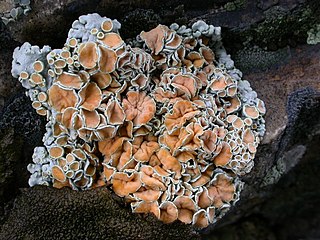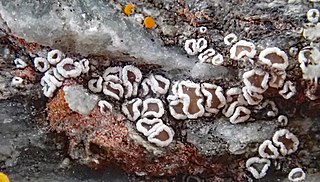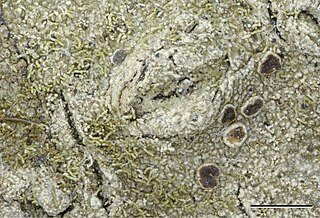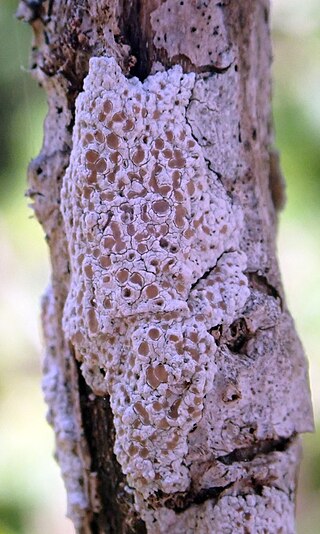
Melanohalea is a genus of foliose lichens in the family Parmeliaceae. It contains 30 mostly Northern Hemisphere species that grow on bark or on wood. The genus is characterised by the presence of pseudocyphellae, usually on warts or on the tips of isidia, a non-pored epicortex and a medulla containing depsidones or lacking secondary metabolites. Melanohalea was circumscribed in 2004 as a segregate of the morphologically similar genus Melanelia, which was created in 1978 for certain brown Parmelia species. The methods used to estimate the evolutionary history of Melanohalea suggest that its diversification primarily occurred during the Miocene and Pliocene epochs.

Rhizoplaca is a genus of lichenized fungi in the family Lecanoraceae. Members of the genus are commonly called rimmed navel lichens because of their umbilicate growth form and lecanorine apothecia, also rock-posy lichen and rockbright.
Lecanora mugambii is a species of crustose lichen in the family Lecanoraceae. Found in western Kenya, it was described as new to science in 2011.
Lecanora printzenii is a species of crustose lichen in the family Lecanoraceae. Originally found in Spain, it was described as new to science in 2011. It shares several characteristics with lichens of the Lecanora varia group but is differentiated by its unique sequence in the internal transcribed spacer (ITS) region of its DNA and by several distinctive physical characteristics.

Protoparmeliopsis garovaglii is a species of saxicolous (rock-dwelling), crustose lichen in the family Lecanoraceae. The species was originally described as Placodium garovaglii by German lichenologist Gustav Wilhelm Körber in 1859. It was later classified in Lecanora in 1900, and known as a member of that genus for more than a century. Molecular phylogenetics showed that Lecanora was highly polyphyletic, and as a result, the genus was divided into several smaller, more phylogenetically natural genera. Subsequently, in 2015, Lecanora garovaglii was transferred to genus Protoparmeliopsis.

Palicella is a genus of crustose lichens in the family Lecanoraceae. It contains six species.

Myriolecis is a genus of lichen in the family Lecanoraceae. It was originally circumscribed in 1909 by Frederic E. Clements with Myriolecis sambuci as the type species. The genus was later reinstated to accommodate the Lecanora disperse group and Arctopeltis. Molecular phylogenetic data showed that this group of species formed a clade that is genetically distinct from Lecanora, and Myriolecis was the oldest name available to hold these species.

Lecanora polytropa, the granite-speck rim lichen, is a species of saxicolous (rock-dwelling), crustose lichen in the family Lecanoraceae. A small, inconspicuous species that grows in the cracks of rock surfaces, it has a cosmopolitan distribution and has been recorded on all continents, including Antarctica.

Neoprotoparmelia is a genus of crustose lichens that was created in 2018. It contains 24 tropical and subtropical species that mostly grow on bark. Neoprotoparmelia is in the subfamily Protoparmelioideae of the family Parmeliaceae, along with the morphologically similar genera Protoparmelia and Maronina.
Lecanora solaris is a species of crustose lichen in the family Lecanoraceae. Found in the Altai Mountains in Russia, the lichen was described as new to science in 2019 by Lydia Yakovchenko and Evgeny Davydov. The lichen is similar in general morphology to Lecanora somervellii, but can be distinguished from that species by its small, squamulose (scaly) to marginally lobate umbilicate thallus and the persistent margin of its apothecia. The species epithet makes reference to the bright yellow colour of the lichen.

Lecanora kohu is a species of lichen in the family Lecanoraceae. Found in the Chatham Islands of New Zealand, it was formally described as new to science in 2017.

The Rhizocarpales are an order of lichen-forming fungi in the subclass Lecanoromycetidae of the class Lecanoromycetes. It has two families, Rhizocarpaceae and Sporastatiaceae, which contain mostly crustose lichens.
Lecanora achroa is a species of crustose lichen in the family Lecanoraceae. It was originally described in 1876 by Finnish botanist William Nylander from specimens collected in Rodrigues, Mauritius. The lichen is found in Australia, New Zealand, Papua New Guinea, and North and South America.
Lecanora luteomarginata is a species of saxicolous (rock-dwelling) and crustose lichen in the family Lecanoraceae. Found in India, it was formally described as a new species in 2006 by Sanjeeva Nayaka, Dalip Kumar Upreti, and H. Thorsten Lumbsch. The type specimen was collected in the trail from Gaurikund to Rambara in the valley of the Mandakini River at an elevation ranging from between 1,980 and 2,800 m. It is only known from the type locality. Characteristics of the lichen include its thin, smooth thallus, dark brown apothecia with bright yellow margins, melacarpella-type amphithecia and glabrata-type epihymenia. The specific epithet luteomarginata refers to the yellow-coloured apothecial margins. Secondary compounds in the lichen include arthothelin, atranorin, chloroatranorin, and thiophanic acid.
Lecanora lojkahugoi is a species of saxicolous (rock-dwelling) crustose lichen in the family Lecanoraceae. It is found in the Russian Far East and in South Korea.
Lecanora helmutii is a rare species of corticolous (bark-dwelling), crustose lichen in the family Lecanoraceae. Found in Tasmania, it was formally described as a new species in 2018 by Sergio Pérez-Ortega and Gintaras Kantvilas. The type specimen was collected from the eastern side of Stanley Highway, where it was found growing on the bark of Banksia marginata in a coastal swampy woodland dominated by Melaleuca. It is only known from the type collection. Other associated lichens include Austroparmelina pseudorelicina, Bactropsora paludicola, Menegazzia subpertusa, Pannaria elixii, and Parmotrema perlatum. The species epithet honours Austrian lichenologist Helmut Mayrhofer.

Rhizoplaca novomexicana is a species of saxicolous (rock-dwelling), crustose lichen in the family Lecanoraceae. Found in North America, the lichen was first formally described as a new species in 1932 by Adolf Hugo Magnusson, as a member of the genus Lecanora. Sergey Kondratyuk proposed a transfer to the genus Protoparmeliopsis in 2012. Steven Leavitt, Xin Zhao, and H. Thorsten Lumbsch transferred it to the genus Rhizoplaca in 2015, when, following molecular phylogenetics analysis, they emended that genus to include three placodioid species previously placed in Lecanora.

Glaucomaria is a genus of lichen-forming fungi in the family Lecanoraceae. It has seven species. The genus was circumscribed by Maurice Choisy in 1929. It contains crustose lichens formerly placed in the Lecanora rupicola species complex as defined by several previous authors.
Ramboldia gowardiana is a species of corticolous (bark-dwelling), crustose lichen in the family Ramboldiaceae. First discovered in 2003 in Montana, United States, it typically appears as a grayish or greenish crust on tree bark, particularly on conifers like pines and firs. The lichen is characterised by its small, bright red to orange-red reproductive structures (apothecia) visible on its surface. R. gowardiana is found in dry, temperate forests from Alaska to California, often at elevations between 300 and 1,400 meters. Initially classified in a different genus, it was reclassified as Ramboldia in 2008 based on genetic studies. This lichen is part of the biodiversity of the Pacific Northwest region of North America.










